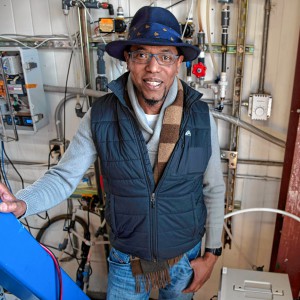Easthampton preps first-ever, far-reaching climate action plan
| Published: 02-09-2023 7:20 PM |
EASTHAMPTON — Easthampton is embarking on its first-ever, far-reaching climate action plan that officials believe will help the city tackle the looming effects of climate change and, in the long run, achieve a cleaner, net-zero carbon-emitting community.
The climate action plan will give officials the ability to identify “surgical action steps” to decarbonize Easthampton as soon as possible, said Mayor Nicole LaChapelle.
“The plan will prioritize actions from highest impact to lowest and align to federal and state grants. The reality is the city’s reduction overall is small,” LaChapelle said. “The long-game here is a playbook that gets residents the tech and monetary support needed to decarbonize.”
As part of that effort, the city has signed a contract with Weston & Sampson, a Reading-based engineering firm, to develop the plan that will allow the municipality to examine the city’s dependence on fossil fuels and see how effective some of the projects that are already underway have been in reducing that carbon output.
Over the next month, Weston & Sampson’s team will establish a baseline assessment of the city’s dependency on fossil fuels. The firm will then spend the next five months identifying and analyzing the barriers to “green” changes for the city, residents and local businesses, said Easthampton Conservation Agent Cassie Tragert, who worked with the city’s Energy Advisory Committee and the Planning Department to create the grant application.
The plan will also analyze ways to increase the city’s climate resiliency and recommend actions that city workers, businesses and residents can take to make the most of the upcoming state and federal incentives to support these improvements.
“After identifying an achievable timeline and specific means of accomplishing net-zero carbon emissions, the plan will include guidance on tracking our progress and establishing benchmark goals,” Tragert said. “It’s a big task, but not unprecedented. It’s a crucial plan to navigate where to go next in terms of eliminating our fossil fuel dependence.”
Weston & Sampson’s fee to create the plan is approximately $150,000. To pay for the firm’s services, LaChapelle has pledged to use $100,000 of Easthampton’s share of American Rescue Plan Act funds and a $50,000 grant the city was recently awarded from the state’s Best Practices Community Compact Program.
Article continues after...
Yesterday's Most Read Articles
The climate action plan will also emphasize learning from and supporting the city’s state-designated environmental justice neighborhoods. Such neighborhoods are predominantly inhabited by persons of color or have a substantial proportion of the population living below the poverty line, and are the most vulnerable to the threats of climate change.
Easthampton neighborhoods qualify for the designation under the income criteria. About 26% of the city’s population lives in environmental justice neighborhoods, according to the state’s Executive Office of Energy and Environmental Affairs.
“Public outreach will be an integral part of the creation of this plan and collaboration with various boards, committees, and departments in Easthampton, which will help to ensure that it is designed specifically for success in our community,” Tragert said.
The city’s work to combat the effects of climate change date to at least 2008, when the city incorporated the impacts of a changing climate into its master plan, according to City Planner Jeff Bagg.
Two years later, the city became a state-designated “Green Community” and has since completed efficiency improvement grants that were offered through the program in 2010, 2014, 2019 and 2022.
In 2012, the city approved installation of a 2.3-megawatt photovoltaic solar farm on the capped Oliver Street landfill.
More recently, the city has installed two electric vehicle charging stations that have a capacity to accommodate eight cars, and two fully electric police cruisers have been purchased for the Police Department.
“The need to take on the development of this comprehensive plan has been emphasized since the City Council passed its resolution declaring a climate emergency in 2021,” Bagg said. “The city has been working toward increasing our resiliency to the impacts of climate change through previous actions, such as continuing our commitment to maintaining our Green Community designation, utilizing Municipal Vulnerability Preparedness planning and action grants, and establishing EV chargers and ValleyBike connections.”
The climate action plan will incorporate all of the city’s ongoing projects.
Other initiatives include the implementation of the green infrastructure master plan, including improvements to Cherry Street, building new sidewalks, and reviewing possible improvements to municipal buildings through the Honeywell conservation project, such as solar installations.
The city has also partnered with the Conway School of Ecological Landscape Design and Planning to create a pollinator action plan with the intention of increasing pollinator habitat on both public and private lands in the city.
“The Municipal Vulnerability Plan identified naturalizing lawn space as an important action, and the pollinator plan should also complement the climate action plan that the city will be starting soon,” Assistant City Planner Eli Bloch said.
Simultaneously, At-Large City Councilor Owen Zaret has proposed making Easthampton an official Xerces Society “Bee City” and create a committee that focuses on supporting pollinators.
“Native plants play a vital role in our local ecology in regard to providing natural food and shelter for birds and invertebrate pollinators,” Zaret said in a statement. “They are naturally hardy to the region and require significantly less maintenance. Without the appropriate eco regional native plants, trees, and shrubs our birds, bats, bees, butterflies, moths etc, will have no food and shelter sources and will see collapse.”
The framework for the society’s program provided him with all of the details he felt were needed for crafting a city policy, which include: establishing dedicated pollinator habitat, creating native plant and pesticide policies, and providing resident education.
The Planning Department and Zaret worked with the Conway School on outlining the goals of the project and created a steering committee, which includes Bloch, Zaret, and Easthampton residents Bex Zumbruski and Mari Harrison.
This Saturday, graduate students from the Conway School will conduct interactive community engagement during Winterfest from 9 a.m. to 3 p.m. at the Keystone Mill building and from 11 a.m. to 2 p.m. outside the city Municipal Building to begin developing a plan. The students are also collecting feedback via an online survey at easthamptonma.gov/703/Pollinator-Action-Plan.
Tragert estimates the city’s climate action plan will be completed within the next 18 months.
Prior to that, Weston & Sampson will be part of public meetings in the summer and fall of this year, and will lead a presentation to the City Council in early 2024.
“I encourage residents to stay tuned for requests for public input and future meetings,” said Tragert.
Emily Thurlow can be reached at ethurlow@gazettenet.com.
 William Strickland, a longtime civil rights activist, scholar and friend of Malcolm X, has died
William Strickland, a longtime civil rights activist, scholar and friend of Malcolm X, has died Advancing water treatment: UMass startup Elateq Inc. wins state grant to deploy new technology
Advancing water treatment: UMass startup Elateq Inc. wins state grant to deploy new technology New Realtor Association CEO looks to work collaboratively to maximize housing options
New Realtor Association CEO looks to work collaboratively to maximize housing options Northampton man will go to trial on first-degree murder charge after plea agreement talks break down
Northampton man will go to trial on first-degree murder charge after plea agreement talks break down 
